溶液配制药典
- 格式:doc
- 大小:83.50 KB
- 文档页数:15
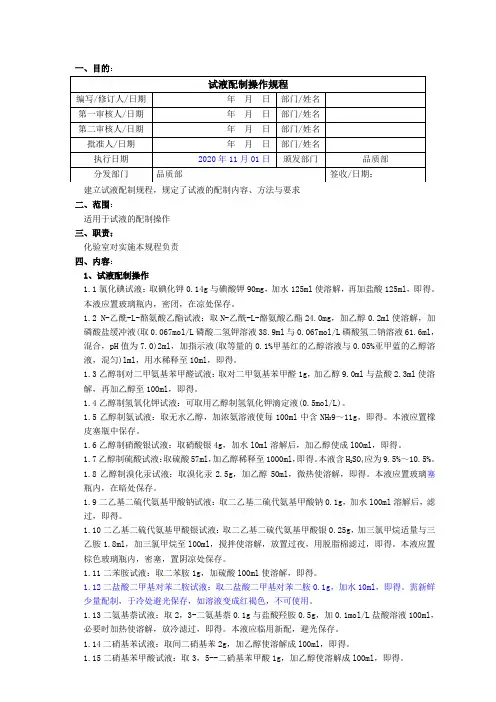
一、目的:建立试液配制规程,规定了试液的配制内容、方法与要求二、范围:适用于试液的配制操作三、职责:化验室对实施本规程负责四、内容:1、试液配制操作1.1氯化碘试液:取碘化钾0.14g与碘酸钾90mg,加水125ml使溶解,再加盐酸125ml,即得。
本液应置玻璃瓶内,密闭,在凉处保存。
1.2 N-乙酰-L-酪氨酸乙酯试液:取N-乙酰-L-酪氨酸乙酯24.0mg,加乙醇0.2ml使溶解,加磷酸盐缓冲液(取0.067mol/L磷酸二氢钾溶液38.9ml与0.067mol/L磷酸氢二钠溶液61.6ml,混合,pH值为7.0)2ml,加指示液(取等量的0.1%甲基红的乙醇溶液与0.05%亚甲蓝的乙醇溶液,混匀)lml,用水稀释至10ml,即得。
1.3乙醇制对二甲氨基苯甲醛试液:取对二甲氨基苯甲醛1g,加乙醇9.0ml与盐酸2.3ml使溶解,再加乙醇至100ml,即得。
1.4乙醇制氢氧化钾试液:可取用乙醇制氢氧化钾滴定液(0.5mol/L)。
1.5乙醇制氨试液:取无水乙醇,加浓氨溶液使每100ml中含NH39~11g,即得。
本液应置橡皮塞瓶中保存。
1.6乙醇制硝酸银试液:取硝酸银4g,加水l0ml溶解后,加乙醇使成l00ml,即得。
1.7乙醇制硫酸试液:取硫酸57ml,加乙醇稀释至1000ml,即得。
本液含H2SO4应为9.5%~10.5%。
1.8乙醇制溴化汞试液:取溴化汞2.5g,加乙醇50ml,微热使溶解,即得。
本液应置玻璃塞瓶内,在暗处保存。
1.9二乙基二硫代氨基甲酸钠试液:取二乙基二硫代氨基甲酸钠0.1g,加水l00ml溶解后,滤过,即得。
1.10二乙基二硫代氨基甲酸银试液:取二乙基二硫代氨基甲酸银0.25g,加三氯甲烷适量与三乙胺1.8ml,加三氯甲烷至l00ml,搅拌使溶解,放置过夜,用脱脂棉滤过,即得。
本液应置棕色玻璃瓶内,密塞,置阴凉处保存。
1.11二苯胺试液:取二苯胺1g,加硫酸l00ml使溶解,即得。
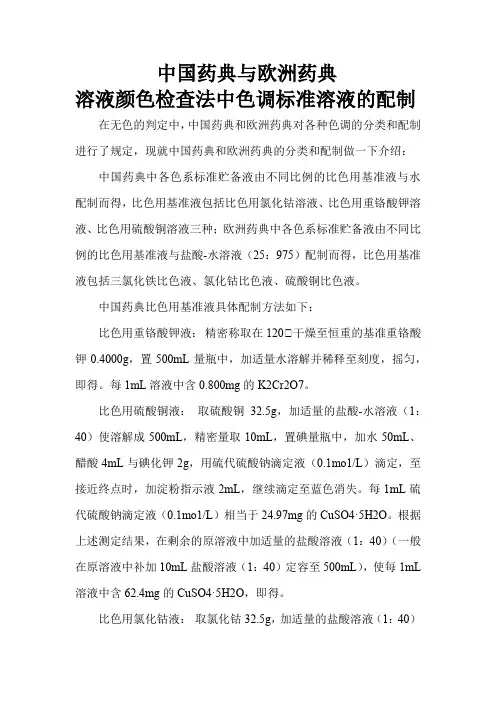
中国药典与欧洲药典溶液颜色检查法中色调标准溶液的配制在无色的判定中,中国药典和欧洲药典对各种色调的分类和配制进行了规定,现就中国药典和欧洲药典的分类和配制做一下介绍:中国药典中各色系标准贮备液由不同比例的比色用基准液与水配制而得,比色用基准液包括比色用氯化钴溶液、比色用重铬酸钾溶液、比色用硫酸铜溶液三种;欧洲药典中各色系标准贮备液由不同比例的比色用基准液与盐酸-水溶液(25:975)配制而得,比色用基准液包括三氯化铁比色液、氯化钴比色液、硫酸铜比色液。
中国药典比色用基准液具体配制方法如下:比色用重铬酸钾液:精密称取在120℃干燥至恒重的基准重铬酸钾0.4000g,置500mL量瓶中,加适量水溶解并稀释至刻度,摇匀,即得。
每1mL溶液中含0.800mg的K2Cr2O7。
比色用硫酸铜液:取硫酸铜32.5g,加适量的盐酸-水溶液(1:40)使溶解成500mL,精密量取10mL,置碘量瓶中,加水50mL、醋酸4mL与碘化钾2g,用硫代硫酸钠滴定液(0.1mo1/L)滴定,至接近终点时,加淀粉指示液2mL,继续滴定至蓝色消失。
每1mL硫代硫酸钠滴定液(0.1mo1/L)相当于24.97mg的CuSO4·5H2O。
根据上述测定结果,在剩余的原溶液中加适量的盐酸溶液(1:40)(一般在原溶液中补加10mL盐酸溶液(1:40)定容至500mL),使每1mL 溶液中含62.4mg的CuSO4·5H2O,即得。
比色用氯化钴液:取氯化钴32.5g,加适量的盐酸溶液(1:40)使溶解成500mL,精密量取2mL,置锥形瓶中,加水200mL,摇匀,加氨试液至溶液由浅红色转变至绿色后,加醋酸-醋酸钠缓冲液(pH6.0)10mL,加热至60℃,再加二甲酚橙指示液5滴,用乙二胺四醋酸二钠滴定液(0.05mo1/L)滴定至溶液显黄色。
每1mL乙二胺四醋酸二钠滴定液(0.05mo1/L)相当于11.90mg的CoCl2·6H2O。
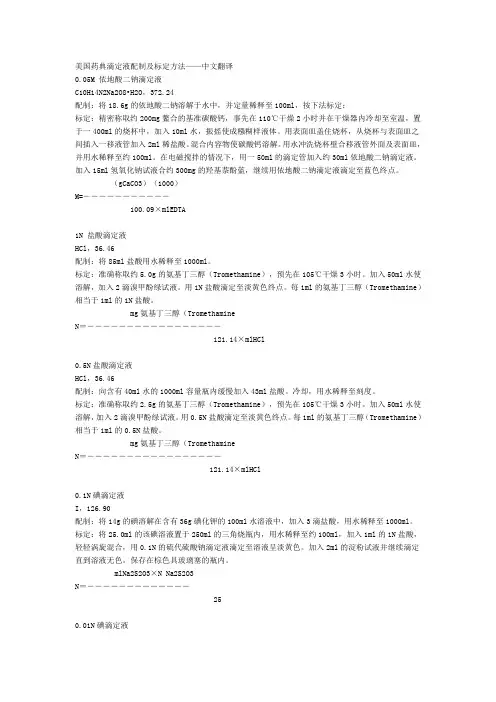
美国药典滴定液配制及标定方法——中文翻译0.05M 依地酸二钠滴定液C10H14N2Na2O8•H2O,372.24配制:将18.6g的依地酸二钠溶解于水中,并定量稀释至100ml,按下法标定:标定:精密称取约200mg鳌合的基准碳酸钙,事先在110℃干燥2小时并在干燥器内冷却至室温,置于一400ml的烧杯中,加入10ml水,振摇使成糨糊样液体。
用表面皿盖住烧杯,从烧杯与表面皿之间插入一移液管加入2ml稀盐酸。
混合内容物使碳酸钙溶解。
用水冲洗烧杯壁合移液管外面及表面皿,并用水稀释至约100ml。
在电磁搅拌的情况下,用一50ml的滴定管加入约30ml依地酸二钠滴定液。
加入15ml氢氧化钠试液合约300mg的羟基萘酚蓝,继续用依地酸二钠滴定液滴定至蓝色终点。
(gCaCO3)(1000)M=―――――――――――100.09×mlEDTA1N 盐酸滴定液HCl,36.46配制:将85ml盐酸用水稀释至1000ml。
标定:准确称取约5.0g的氨基丁三醇(Tromethamine),预先在105℃干燥3小时。
加入50ml水使溶解,加入2滴溴甲酚绿试液。
用1N盐酸滴定至淡黄色终点。
每1ml的氨基丁三醇(Tromethamine)相当于1ml的1N盐酸。
mg氨基丁三醇(TromethamineN=―――――――――――――――――121.14×mlHCl0.5N盐酸滴定液HCl,36.46配制:向含有40ml水的1000ml容量瓶内缓慢加入43ml盐酸。
冷却,用水稀释至刻度。
标定:准确称取约2.5g的氨基丁三醇(Tromethamine),预先在105℃干燥3小时。
加入50ml水使溶解,加入2滴溴甲酚绿试液。
用0.5N盐酸滴定至淡黄色终点。
每1ml的氨基丁三醇(Tromethamine)相当于1ml的0.5N盐酸。
mg氨基丁三醇(TromethamineN=―――――――――――――――――121.14×mlHCl0.1N碘滴定液I,126.90配制:将14g的碘溶解在含有36g碘化钾的100ml水溶液中,加入3滴盐酸,用水稀释至1000ml。
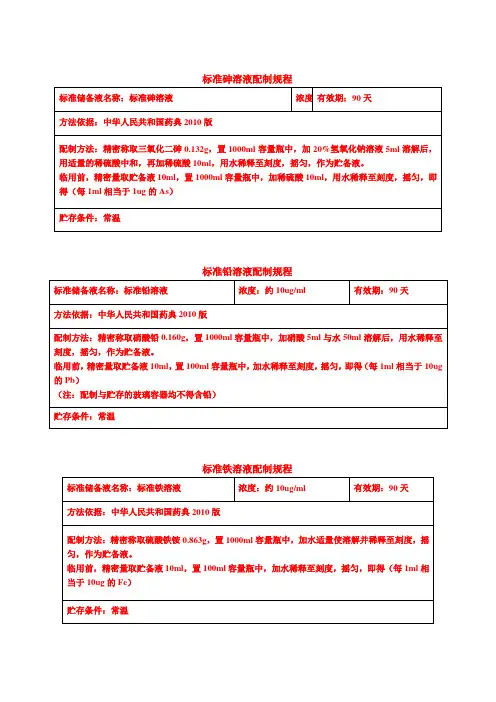
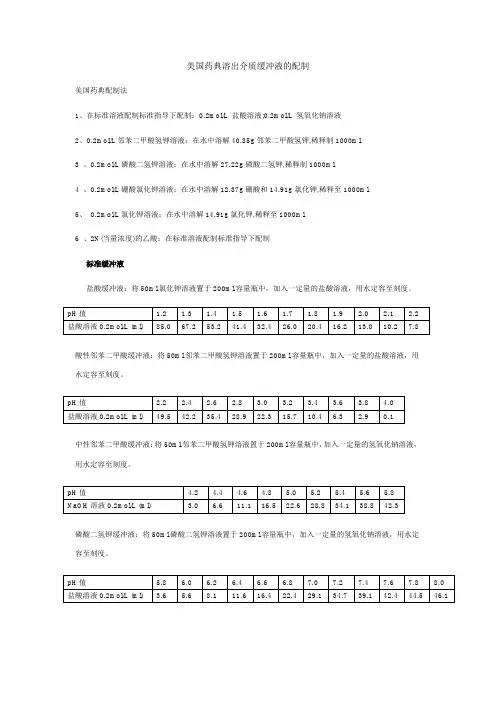
美国药典溶出介质缓冲液的配制
美国药典配制法
1、在标准溶液配制标准指导下配制:0.2mol/L 盐酸溶液;0.2mol/L 氢氧化钠溶液
2、0.2mol/L邻苯二甲酸氢钾溶液:在水中溶解40.85g邻苯二甲酸氢钾,稀释制1000ml
3 、0.2mol/L磷酸二氢钾溶液:在水中溶解27.22g磷酸二氢钾,稀释制1000ml
4 、0.2mol/L硼酸氯化钾溶液:在水中溶解12.37g硼酸和14.91g氯化钾,稀释至1000ml
5、0.2mol/L氯化钾溶液:在水中溶解14.91g氯化钾,稀释至1000ml
6 、2N(当量浓度)的乙酸:在标准溶液配制标准指导下配制
标准缓冲液
盐酸缓冲液:将50ml氯化钾溶液置于200ml容量瓶中,加入一定量的盐酸溶液,用水定容至刻度。
酸性邻苯二甲酸缓冲液:将50ml邻苯二甲酸氢钾溶液置于200ml容量瓶中,加入一定量的盐酸溶液,用水定容至刻度。
中性邻苯二甲酸缓冲液:将50ml邻苯二甲酸氢钾溶液置于200ml容量瓶中,加入一定量的氢氧化钠溶液,用水定容至刻度。
磷酸二氢钾缓冲液:将50ml磷酸二氢钾溶液置于200ml容量瓶中,加入一定量的氢氧化钠溶液,用水定容至刻度。
碱性硼酸缓冲液:将50ml硼酸氯化钾溶液置于200ml容量瓶中,加入一定量的氢氧化钠溶液,用水定容至刻度。
醋酸缓冲液:将规定量的三水乙酸纳置于1000ml容量瓶中,加入规定量的乙酸溶液,用水定容至刻度,混匀。
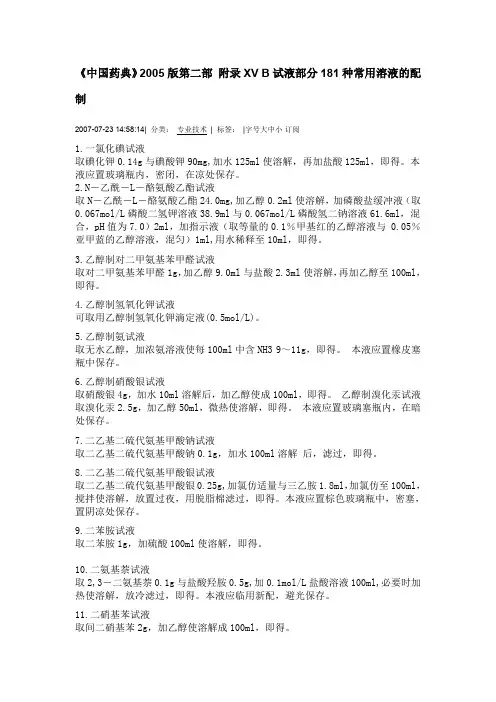
《中国药典》2005版第二部附录XV B试液部分181种常用溶液的配制2007-07-23 14:58:14| 分类:专业技术| 标签:|字号大中小订阅1.一氯化碘试液取碘化钾0.14g与碘酸钾90mg,加水125ml使溶解,再加盐酸125ml,即得。
本液应置玻璃瓶内,密闭,在凉处保存。
2.N-乙酰-L-酪氨酸乙酯试液取N-乙酰-L-酪氨酸乙酯24.0mg,加乙醇0.2ml使溶解,加磷酸盐缓冲液(取0.067mol/L磷酸二氢钾溶液38.9ml与0.067mol/L磷酸氢二钠溶液61.6ml,混合,pH值为7.0)2ml,加指示液(取等量的0.1%甲基红的乙醇溶液与 0.05%亚甲蓝的乙醇溶液,混匀)1ml,用水稀释至10ml,即得。
3.乙醇制对二甲氨基苯甲醛试液取对二甲氨基苯甲醛1g,加乙醇9.0ml与盐酸2.3ml使溶解,再加乙醇至100ml,即得。
4.乙醇制氢氧化钾试液可取用乙醇制氢氧化钾滴定液(0.5mol/L)。
5.乙醇制氨试液取无水乙醇,加浓氨溶液使每100ml中含NH3 9~11g,即得。
本液应置橡皮塞瓶中保存。
6.乙醇制硝酸银试液取硝酸银4g,加水10ml溶解后,加乙醇使成100ml,即得。
乙醇制溴化汞试液取溴化汞2.5g,加乙醇50ml,微热使溶解,即得。
本液应置玻璃塞瓶内,在暗处保存。
7.二乙基二硫代氨基甲酸钠试液取二乙基二硫代氨基甲酸钠0.1g,加水100ml溶解后,滤过,即得。
8.二乙基二硫代氨基甲酸银试液取二乙基二硫代氨基甲酸银0.25g,加氯仿适量与三乙胺1.8ml,加氯仿至100ml,搅拌使溶解,放置过夜,用脱脂棉滤过,即得。
本液应置棕色玻璃瓶中,密塞,置阴凉处保存。
9.二苯胺试液取二苯胺1g,加硫酸100ml使溶解,即得。
10.二氨基萘试液取2,3-二氨基萘0.1g与盐酸羟胺0.5g,加0.1mol/L盐酸溶液100ml,必要时加热使溶解,放冷滤过,即得。
本液应临用新配,避光保存。
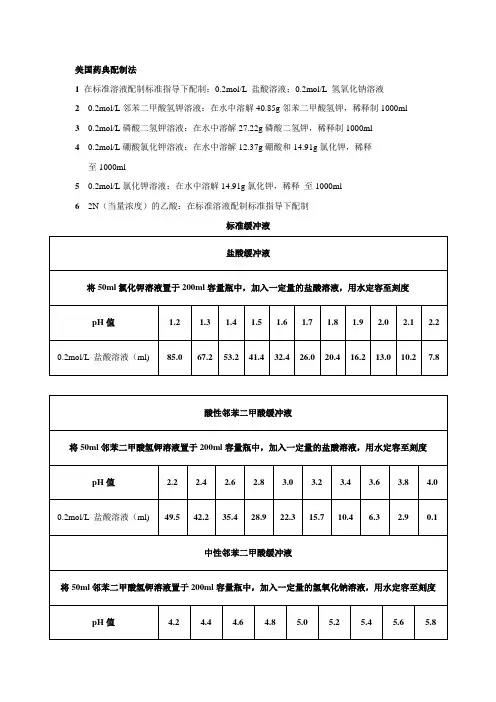
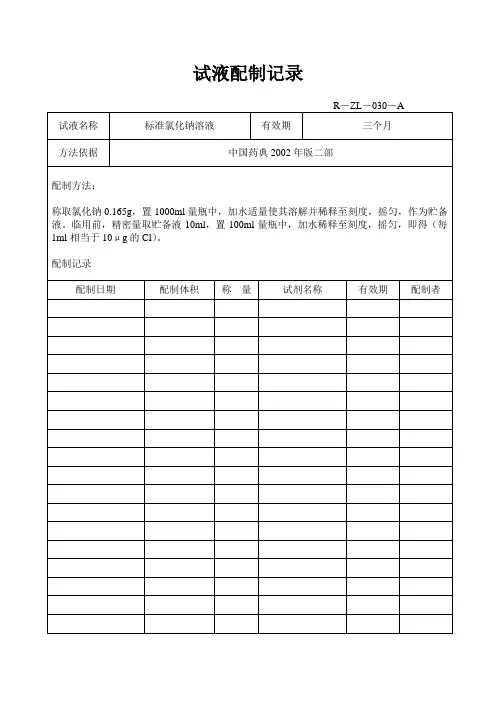
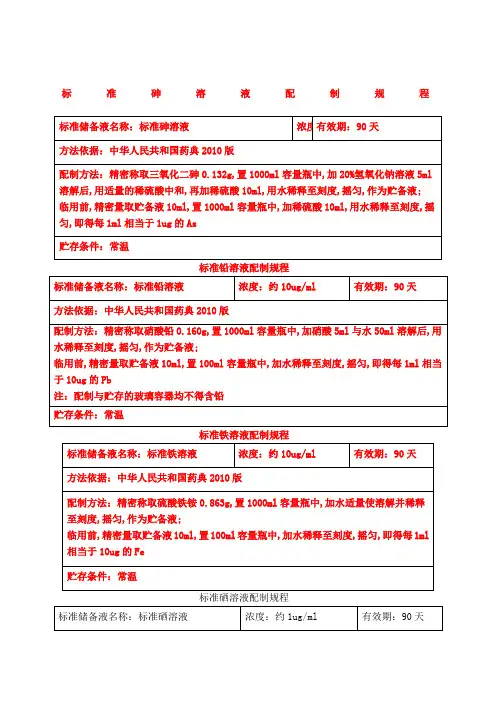
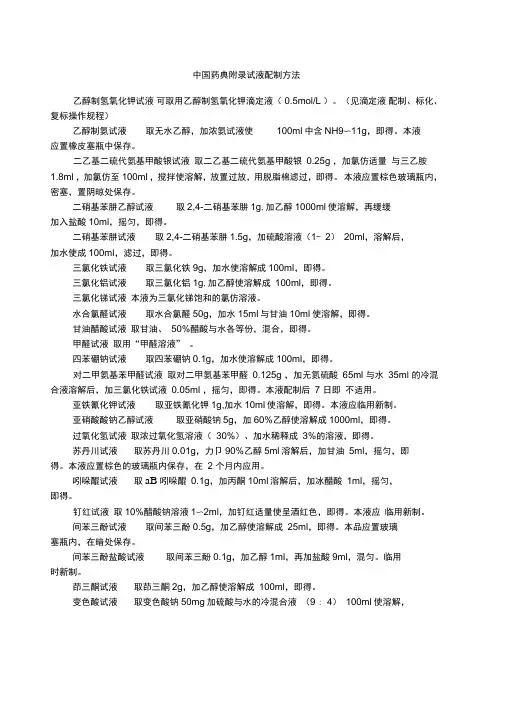
中国药典附录试液配制方法乙醇制氢氧化钾试液可取用乙醇制氢氧化钾滴定液(0.5mol/L )。
(见滴定液配制、标化、复标操作规程)乙醇制氨试液取无水乙醇,加浓氨试液使100ml中含NH9〜11g,即得。
本液应置橡皮塞瓶中保存。
二乙基二硫代氨基甲酸银试液取二乙基二硫代氨基甲酸银0.25g ,加氯仿适量与三乙胺1.8ml ,加氯仿至100ml ,搅拌使溶解,放置过放,用脱脂棉滤过,即得。
本液应置棕色玻璃瓶内,密塞,置阴晾处保存。
二硝基苯肼乙醇试液取2,4-二硝基苯肼1g,加乙醇1000ml使溶解,再缓缓加入盐酸10ml,摇匀,即得。
二硝基苯肼试液取2,4-二硝基苯肼1.5g,加硫酸溶液(1- 2)20ml,溶解后,加水使成100ml,滤过,即得。
三氯化铁试液取三氯化铁9g,加水使溶解成100ml,即得。
三氯化铝试液取三氯化铝1g,加乙醇使溶解成100ml,即得。
三氯化锑试液本液为三氯化锑饱和的氯仿溶液。
水合氯醛试液取水合氯醛50g,加水15ml与甘油10ml使溶解,即得。
甘油醋酸试液取甘油、50%醋酸与水各等份,混合,即得。
甲醛试液取用“甲醛溶液” 。
四苯硼钠试液取四苯硼钠0.1g,加水使溶解成100ml,即得。
对二甲氨基苯甲醛试液取对二甲氨基苯甲醛0.125g ,加无氮硫酸65ml 与水35ml 的冷混合液溶解后,加三氯化铁试液0.05ml ,摇匀,即得。
本液配制后7 日即不适用。
亚铁氰化钾试液取亚铁氰化钾1g,加水10ml使溶解,即得。
本液应临用新制。
亚硝酸酸钠乙醇试液取亚硝酸钠5g,加60%乙醇使溶解成1000ml,即得。
过氧化氢试液取浓过氧化氢溶液(30%)、加水稀释成3%的溶液,即得。
苏丹川试液取苏丹川0.01g,力卩90%乙醇5ml溶解后,加甘油5ml,摇匀,即得。
本液应置棕色的玻璃瓶内保存,在2 个月内应用。
吲哚醌试液取aB吲哚醌0.1g,加丙酮10ml溶解后,加冰醋酸1ml,摇匀,即得。
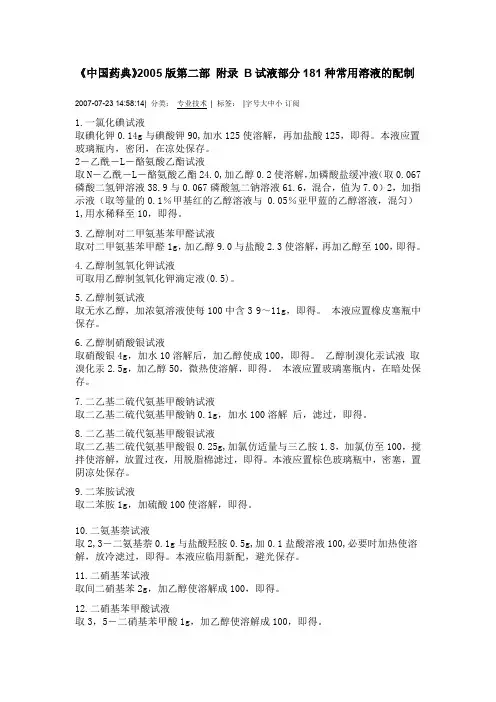
《中国药典》2005版第二部附录B试液部分181种常用溶液的配制2007-07-23 14:58:14| 分类:专业技术| 标签:|字号大中小订阅1.一氯化碘试液取碘化钾0.14g与碘酸钾90,加水125使溶解,再加盐酸125,即得。
本液应置玻璃瓶内,密闭,在凉处保存。
2-乙酰-L-酪氨酸乙酯试液取N-乙酰-L-酪氨酸乙酯24.0,加乙醇0.2使溶解,加磷酸盐缓冲液(取0.067磷酸二氢钾溶液38.9与0.067磷酸氢二钠溶液61.6,混合,值为7.0)2,加指示液(取等量的0.1%甲基红的乙醇溶液与 0.05%亚甲蓝的乙醇溶液,混匀)1,用水稀释至10,即得。
3.乙醇制对二甲氨基苯甲醛试液取对二甲氨基苯甲醛1g,加乙醇9.0与盐酸2.3使溶解,再加乙醇至100,即得。
4.乙醇制氢氧化钾试液可取用乙醇制氢氧化钾滴定液(0.5)。
5.乙醇制氨试液取无水乙醇,加浓氨溶液使每100中含3 9~11g,即得。
本液应置橡皮塞瓶中保存。
6.乙醇制硝酸银试液取硝酸银4g,加水10溶解后,加乙醇使成100,即得。
乙醇制溴化汞试液取溴化汞2.5g,加乙醇50,微热使溶解,即得。
本液应置玻璃塞瓶内,在暗处保存。
7.二乙基二硫代氨基甲酸钠试液取二乙基二硫代氨基甲酸钠0.1g,加水100溶解后,滤过,即得。
8.二乙基二硫代氨基甲酸银试液取二乙基二硫代氨基甲酸银0.25g,加氯仿适量与三乙胺1.8,加氯仿至100,搅拌使溶解,放置过夜,用脱脂棉滤过,即得。
本液应置棕色玻璃瓶中,密塞,置阴凉处保存。
9.二苯胺试液取二苯胺1g,加硫酸100使溶解,即得。
10.二氨基萘试液取2,3-二氨基萘0.1g与盐酸羟胺0.5g,加0.1盐酸溶液100,必要时加热使溶解,放冷滤过,即得。
本液应临用新配,避光保存。
11.二硝基苯试液取间二硝基苯2g,加乙醇使溶解成100,即得。
12.二硝基苯甲酸试液取3,5-二硝基苯甲酸1g,加乙醇使溶解成100,即得。
溶解度是药品的一种物理性质。
各正文品种项下选用的部分溶剂及其在该溶剂中的溶解性能,可供精制或制备溶液时参考;对在特定溶剂中的溶解性能需作质量控制时,应在该品种检查项下另作具体规定。
药品的近似溶解度以下列名词表示:极易溶解系指溶质1g(ml)能在溶剂不到1ml中溶解;易溶系指溶质1g(ml)能在溶剂1~不到10ml中溶解;溶解系指溶质1g(ml)能在溶剂10~不到30ml中溶解;略溶系指溶质1g(ml)能在溶剂30~不到100ml中溶解;微溶系指溶质1g(ml)能在溶剂100~不到1000ml中溶解;极微溶解系指溶质1g(ml)能在溶剂1000~不到10000ml中溶解;几乎不溶或不溶系指溶质1g(ml)在溶剂10000ml中不能完全溶解。
试验法:除另有规定外,称取研成细粉的供试品或量取液体供试品,置于25℃±2℃一定容量的溶剂中,每隔5分钟强力振摇30秒钟;观察30分钟内的溶解情况,如看不见溶质颗粒或液滴时,即视为完全溶解。
十一、贮藏项下的规定,系对药品贮存与保管的基本要求,以下列名词表示:遮光系指用不透光的容器包装,例如棕色容器或黑纸包裹的无色透明、半透明容器;密闭系指将容器密闭,以防止尘土及异物进入;密封系指将容器密封以防止风化、吸潮、挥发或异物进入;熔封或严封系指将容器熔封或用适宜的材料严封,以防止空气与水分的侵入并防止污染;阴凉处系指不超过20℃;凉暗处系指避光并不超过20℃;冷处系指2~10℃。
常温系指10~30℃(3) 温度以摄氏度(℃)表示水浴温度除另有规定外,均指98~100℃;热水系指70~80℃;微温或温水系指40~50℃;室温系指10~30℃;冷水系指2~10℃;冰浴系指2℃以下;冰浴系指约0℃;放冷系指放冷至室温。
(4) 百分比用“%”符号表示,系指重量的比例;但溶液的百分比,除另有规定外,系指溶液100ml中含有溶质若干克;乙醇的百分比,系指在20℃时容量的比例。
TEST SOLUTIONS (TS)Certain of the following test solutions are intended for use as acid-base indicators in volumetric analyses. Such solutions should be so adjusted that when 0.15 mL of the indicator solution is added to 25 mL of carbondioxide-free water, 0.25 mL of 0.02 N acid or alkali, respectively, will produce the characteristic color change. Similar solutions are intended for use in pH measurement. Where no special directions for their preparation are given, the same solution is suitable for both purposes.Where it is directed that a volumetric solution be used as the test solution, standardization of the solution used as TS is not required.In general, the directive to prepare a solution ―fresh‖ indicates that the solution is of limited stability and must be prepared on the day of use.For the preparation of Test Solutions, use reagents of the quality described under Reagents.Acetaldehyde TS —Mix 4 mL of acetaldehyde, 3 mL of alcohol, and 1 mL of water. Prepare this solution fresh.Acetate Buffer TS —Dissolve 320 g of ammonium acetate in 500 mL of water, add 5 mL of glacial acetic acid, dilute with water to 1000.0 mL, and mix. This solution has a pH between 5.9 and 6.0.Acetic Acid, Glacial, TS —Determine the water content of a specimen of glacial acetic acid by the Titrimetric Method (see Water Determination 921). If the acid contains more than 0.05% of water, add a few mL of acetic anhydride, mix, allow to stand overnight, and again determine the water content. If the acid contains less than 0.02% of water, add sufficient water to make the final concentration between 0.02% and 0.05%, mix, allow to stand overnight, and again determine the water content. Repeat the adjustment withacetic anhydride or water, as necessary, until the resulting solution shows a water content between 0.02% and 0.05%.Acetic Acid, Strong, TS —Add 300.0 mL of glacial acetic acid, and dilute with water to 1000 mL. This solution contains about 30% (v/v) of CH3COOH and has a concentration of about 5 N.Acetic Acid–Ammonium Acetate Buffer TS —Dissolve 77.1 g of ammonium acetate in water, add 57 mL of glacial acetic acid, and dilute with water to 1000 mL.Acetone, Buffered, TS —Dissolve 8.15 g of sodium acetate and 42 g of sodium chloride in about 100 mL of water, and add 68 mL of 0.1 N hydrochloric acid and 150 mL of acetone. Mix, and dilute with water to 500 mL.Acid Ferric Chloride TS —Mix 60 mL of glacial acetic acid with 5 mL of sulfuric acid, add 1 mL of ferric chloride TS, mix, and cool.Acid Ferrous Sulfate TS —See Ferrous Sulfate, Acid, TS.Acid Stannous Chloride TS —See Stannous Chloride, Acid, TS.Acid Stannous Chloride TS, Stronger —See Stannous Chloride, Acid, TS.Albumen TS —Carefully separate the white from the yolk of a strictly fresh hen's egg. Shake the white with 100 mL of water until mixed and all but the chalaza has undergone solution; then filter. Prepare the solution fresh.Alcohol–Phenol TS —Dissolve 780 mg of phenol in alcohol to make 100 mL.Alcoholic Ammonia TS —See Ammonia TS, Alcoholic.Alcoholic Mercuric Bromide TS —See Mercuric Bromide TS, Alcoholic.Alcoholic Potassium Hydroxide TS —See Potassium Hydroxide TS, Alcoholic.Alkaline Cupric Citrate TS —See Cupric Citrate TS, Alkaline.Alkaline Cupric Citrate TS 2 —See Cupric Citrate TS 2, Alkaline.Alkaline Cupric Iodide TS —See Cupric Iodide TS, Alkaline.Alkaline Cupric Tartrate TS (Fehling's Solution)—See Cupric Tartrate TS, Alkaline.Alkaline Mercuric–Potassium Iodide TS —See Mercuric–Potassium Iodide TS, Alkaline.Alkaline Picrate TS —See Picrate TS, Alkaline.Alkaline Sodium Hydrosulfite TS —See Sodium Hydrosulfite TS, Alkaline. Amaranth TS —Dissolve 20 mg of amaranth in 10 mL of water.Aminonaphtholsulfonic Acid TS —Accurately weigh 5 g of sodium sulfite, 94.3 g of sodium bisulfite, and 700 mg of 1,2,4-aminonaphtholsulfonic acid, and mix. Prepare aminonaphtholsulfonic acid TS fresh on the day of use by dissolving 1.5 g of the dry mixture in 10 mL of water.Ammonia–Ammonium Chloride Buffer TS —Dissolve 67.5 g of ammonium chloride in water, add 570 mL of ammonium hydroxide, and dilute with water to 1000 mL.Ammonia–Cyanide TS —Dissolve 2 g of potassium cyanide in 15 mL of ammonium hydroxide, and dilute with water to 100 mL.Ammonia TS —It contains between 9.5% and 10.5% of NH3. Prepare by diluting 350 mL of Ammonia Water, Stronger (see in the section, Reagents) with water to make 1000 mL.Ammonia TS, Alcoholic —A solution of ammonia gas in alcohol. Clear, colorless liquid having a strong odor of ammonia. Specific gravity: about 0.80. It contains between 9% and 11% of NH3. Store it in alkali-resistant containers, in a cold place.Ammonia TS, Stronger —Use Ammonia Water, Stronger (see in the section Reagents).Ammoniacal Potassium Ferricyanide TS —Dissolve 2 g of potassium ferricyanide in 75 mL of water, add 25 mL of ammonium hydroxide, and mix.Ammoniated Cupric Oxide TS —See Cupric Oxide, Ammoniated, TS.Ammonium Acetate TS —Dissolve 10 g of ammonium acetate in water to make 100 mL.Ammonium Carbonate TS —Dissolve 20 g of ammonium carbonate and 20 mL of ammonia TS in water to make 100 mL.Ammonium Chloride TS —Dissolve 10.5 g of ammonium chloride in water to make 100 mL.Ammonium Chloride–Ammonium Hydroxide TS —Mix equal volumes of water and ammonium hydroxide, and saturate with ammonium chloride.Ammonium Molybdate TS —Dissolve 6.5 g of finely powdered molybdic acid in a mixture of 14 mL of water and 14.5 mL of ammonium hydroxide. Cool the solution, and add it slowly, with stirring, to a well-cooled mixture of 32 mL of nitric acid and 40 mL of water. Allow to stand for 48 hours, and filter through a fine-porosity, sintered-glass crucible. This solution deteriorates upon standing and is unsuitable for use if, upon the addition of 2 mL of dibasic sodium phosphate TS to 5 mL of the solution, an abundant yellow precipitate does not form at once or after slight warming. Store it in the dark. If a precipitate forms during storage, use only the clear supernatant.Ammonium Oxalate TS —Dissolve 3.5 g of ammonium oxalate in water to make 100 mL.Ammonium Phosphate, Dibasic, TS (Ammonium Phosphate TS)— Dissolve 13 g of dibasic ammonium phosphate in water to make 100 mL.Ammonium Polysulfide TS —Yellow liquid, made by saturating ammonium sulfide TS with sulfur.Ammonium Pyrrolidinedithiocarbamate, Saturated, TS —Add about 10 g of ammonium pyrrolidinedithiocarbamate to a 1000-mL volumetric flask, and dilute with water to volume.Ammonium Reineckate TS —Shake about 500 mg of ammonium reineckate with 20 mL of water frequently during 1 hour, and filter. Use within 2 days.Ammonium Sulfide TS —Saturate ammonia TS with hydrogen sulfide by bubbling hydrogen sulfide gas through the solution for 1 minute. This solution must be freshly prepared. The solution is not rendered turbid either by magnesium sulfate TS or by calcium chloride TS (carbonate). This solution is unstable for use if an abundant precipitate of sulfur is present.Residue on ignition: not more than 0.05%.Ammonium Thiocyanate TS —Dissolve 8 g of ammonium thiocyanate in water to make 100 mL.Ammonium Vanadate TS —Dissolve 2.5 g of ammonium vanadate in 500 mL of boiling water, cool, and add 20 mL of nitric acid. Mix, cool, and add water to make 1 L. Store in polyethylene containers.Anthrone TS —Within 12 hours of use, rapidly dissolve 35 mg of anthrone in a hot mixture of 35 mL of water and 65 mL of sulfuric acid. Immediately cool in an ice bath to room temperature, and filter through glass wool. Allow the solution to stand at room temperature for 30 minutes before use.Antimony Trichloride TS —Dissolve 20 g of antimony trichloride in chloroform to make 100 mL. Filter if necessary.Barium Chloride TS —Dissolve 12 g of barium chloride in water to make 100 mL.Barium Hydroxide TS —A saturated solution of barium hydroxide in recently boiled water. Prepare the solution fresh.Barium Nitrate TS —Dissolve 6.5 g of barium nitrate in water to make 100 mL.Betanaphthol TS —See 2-Naphthol TS.Biuret Reagent TS —Dissolve 1.5 g of cupric sulfate and 6.0 g of potassium sodium tartrate in 500 mL of water in a 1000-mL volumetric flask. Add 300 mL of carbonate-free sodium hydroxide solution (1 in 10), dilute withcarbonate-free sodium hydroxide solution (1 in 10) to 1000 mL, and mix.Blue Tetrazolium TS —Dissolve 500 mg of blue tetrazolium in alcohol to make 100 mL.Brilliant Blue G TS —Transfer 25 mg of brilliant blue G to a 100-mL volumetric flask, add 12.5 mL of alcohol and 25 mL of phosphoric acid, dilute with water to volume, and mix.Bromine TS (Bromine Water)— A saturated solution of bromine, prepared by agitating 2 to 3 mL of bromine with 100 mL of cold water in a glass-stoppered bottle, the stopper of which should be lubricated with petrolatum. Store it in a cold place, protected from light.Bromine–Sodium Acetate TS —Dissolve 100 g of sodium acetate in 1000 mL of glacial acetic acid, add 50 mL of bromine, and mix.p-Bromoaniline TS —Add 8 g of p-bromoaniline to a mixture of 380 mL ofthiourea-saturated glacial acetic acid, 10 mL of sodium chloride solution (1 in 5), 5 mL of oxalic acid solution (1 in 20), and 5 mL of dibasic sodium phosphate solution (1 in 10) in a low-actinic glass bottle. Mix, and allow to stand overnight before using. Protect from light, and use within 7 days.Bromocresol Blue TS —Use Bromocresol Green TS.Bromocresol Green TS —Dissolve 50 mg of bromocresol green in 100 mL of alcohol, and filter if necessary.Bromocresol Green–Methyl Red TS —Dissolve 0.15 g of bromocresol green and 0.1 g of methyl red in 180 mL of alcohol, and dilute with water to 200 mL.Bromocresol Purple TS —Dissolve 250 mg of bromocresol purple in 20 mL of 0.05 N sodium hydroxide, and dilute with water to 250 mL.Bromophenol Blue TS —Dissolve 100 mg of bromophenol blue in 100 mL of diluted alcohol, and filter if necessary.Bromothymol Blue TS —Dissolve 100 mg of bromothymol blue in 100 mL of diluted alcohol, and filter if necessary.Buffered Acetone TS —See Acetone, Buffered, TS.Calcium Chloride TS —Dissolve 7.5 g of calcium chloride in water to make 100 mL.Calcium Hydroxide TS —Use Calcium Hydroxide Topical Solution (USP monograph).Calcium Sulfate TS —A saturated solution of calcium sulfate in water.Ceric Ammonium Nitrate TS —Dissolve 6.25 g of ceric ammonium nitrate in 10 mL of 0.25 N nitric acid. Use within 3 days.Chloral Hydrate TS —Dissolve 50 g of chloral hydrate in a mixture of 15 mL of water and 10 mL of glycerin.Chlorine TS (Chlorine Water)— A saturated solution of chlorine in water. Place the solution in small, completely filled, light-resistant containers. Chlorine TS, even when kept from light and air, is apt to deteriorate. Store it in a cold, dark place. For full strength, prepare this solution fresh.Chromotropic Acid TS —Dissolve 50 mg of chromotropic acid or its disodium salt in 100 mL of 75% sulfuric acid, which may be made by cautiously adding 75 mL of sulfuric acid to 33.3 mL of water.Cobalt–Uranyl Acetate TS —Dissolve, with warming, 40 g of uranyl acetate in a mixture of 30 g of glacial acetic acid and sufficient water to make 500 mL. Similarly, prepare a solution containing 200 g of cobaltous acetate in a mixture of 30 g of glacial acetic acid and sufficient water to make 500 mL. Mix the two solutions while still warm, and cool to 20. Maintain the temperature at 20for about 2 hours to separate the excess salts from solution, and then pass through a dry filter.Cobaltous Chloride TS —Dissolve 2 g of cobaltous chloride in 1 mL of hydrochloric acid and sufficient water to make 100 mL.Congo Red TS —Dissolve 500 mg of congo red in a mixture of 10 mL of alcohol and 90 mL of water.m-Cresol Purple TS —Dissolve 0.10 g of metacresol purple in 13 mL of 0.01 N sodium hydroxide, dilute with water to 100 mL, and mix.Cresol Red TS —Triturate 100 mg of cresol red in a mortar with 26.2 mL of 0.01 N sodium hydroxide until solution is complete, then dilute the solution with water to 250 mL.Cresol Red–Thymol Blue TS —Add 15 mL of thymol blue TS to 5 mL of cresol red TS, and mix.Crystal Violet TS —Dissolve 100 mg of crystal violet in 10 mL of glacial acetic acid.Cupric Acetate TS —Dissolve 100 mg of cupric acetate in about 5 mL of water to which a few drops of acetic acid have been added. Dilute to 100 mL, and filter, if necessary.Cupric Acetate TS, Stronger (Barfoed's Reagent)— Dissolve 13.3 g of cupric acetate in a mixture of 195 mL of water and 5 mL of acetic acid.Cupric-Ammonium Sulfate TS —To cupric sulfate TS add ammonia TS, dropwise, until the precipitate initially formed is nearly but not completely dissolved. Allow to settle, and decant the clear solution. Prepare this solution fresh.Cupric Citrate TS —Dissolve 25 g of cupric sulfate, 50 g of citric acid, and 144 g of anhydrous sodium carbonate in water, and dilute with water to 1000 mL.Cupric Citrate TS, Alkaline —With the aid of heat, dissolve 173 g of dihydrated sodium citrate and 117 g of monohydrated sodium carbonate in about 700 mL of water, and filter through paper, if necessary, to obtain a clear solution. In a separate container dissolve 17.3 g of cupric sulfate in about 100 mL of water, and slowly add this solution, with constant stirring, to the first solution. Cool the mixture, add water to make 1000 mL, and mix.Cupric Citrate TS 2, Alkaline —With the aid of heat, dissolve about 173 g of sodium citrate dihydrate and 117 g of sodium carbonate monohydrate in about 700 mL of water, and filter. In a second flask, dissolve about 27.06 g of cupric sulfate (Cu2O4·5H2O) in about 100 mL of water. Slowly combine the two solutions while stirring, and dilute with water to 1000 mL.Cupric Iodide TS, Alkaline —Dissolve 7.5 g of cupric sulfate (CuSO4·5H2O) in about 100 mL of water. In a separate container dissolve 25 g of anhydrous sodium carbonate, 20 g of sodium bicarbonate, and 25 g of potassium sodium tartrate in about 600 mL of water. With constant stirring, add the cupric sulfate solution to the bottom of the alkaline tartrate solution by means of a funnel that touches the bottom of the container. Add 1.5 g of potassium iodide, 200 g of anhydrous sodium sulfate, 50 to 150 mL of 0.02 M potassium iodate, and sufficient water to make 1000 mL.Cupric Oxide, Ammoniated, TS (Schweitzer's Reagent)—Dissolve 10 g of cupric sulfate in 100 mL of water, add sufficient sodium hydroxide solution (1 in 5) to precipitate the copper hydroxide, collect the latter on a filter, and wash free from sulfate with cold water. Dissolve the precipitate, which must be keptwet during the entire process, in the minimum quantity of ammonia TS necessary for complete solution.Cupric Sulfate TS —Dissolve 12.5 g of cupric sulfate in water to make 100 mL.Cupric Tartrate TS, Alkaline (Fehling's Solution)—The Copper Solution (A)— Dissolve 34.66 g of carefully selected, small crystals of cupric sulfate, showing no trace of efflorescence of adhering moisture, in water to make 500 mL. Store this solution in small, tight containers.The Alkaline Tartrate Solution (B)— Dissolve 173 g of crystallized potassium sodium tartrate and 50 g of sodium hydroxide in water to make 500 mL. Store this solution in small, alkali-resistant containers.For use, mix exactly equal volumes of Solutions A and B at the time required.Delafield's Hematoxylin TS —Prepare 400 mL of a saturated solution of ammonium alum (Solution A). Dissolve 4 g of hematoxylin in 25 mL of alcohol, mix it with Solution A, and allow it to stand for 4 days in a flask closed with a pledget of purified cotton and exposed to light and air (Solution B). Then filter Solution B, and add to it a Solution C consisting of a mixture of 100 mL of glycerin and 100 mL of methanol. Mix, and allow the mixture to stand in a warm place, exposed to light, for 6 weeks until it becomes dark-colored. Store in tightly stoppered bottles.For use in staining endocrine tissue, dilute this test solution with an equal volume of water.Denigès' Reagent —See Mercuric Sulfate TS.Diazobenzenesulfonic Acid TS —Place in a beaker 1.57 g of sulfanilic acid,previously dried at 105for 3 hours, add 80 mL of water and 10 mL of diluted hydrochloric acid, and warm on a steam bath until dissolved. Cool to 15 (some of the sulfanilic acid may separate but will dissolve later), and add slowly, with constant stirring, 6.5 mL of sodium nitrite solution (1 in 10). Then dilute with water to 100 mL.Dichlorofluorescein TS —Dissolve 100 mg of dichlorofluorescein in 60 mL of alcohol, add 2.5 mL of 0.1 N sodium hydroxide, mix, and dilute with water to 100 mL.2,7-Dihydroxynaphthalene TS —Dissolve 100 mg of2,7-dihydroxynaphthalene in 1000 mL of sulfuric acid, and allow the solution to stand until the yellow color disappears. If the solution is very dark, discard it and prepare a new solution from a different supply of sulfuric acid. This solution is stable for approximately 1 month if stored in a dark bottle.Diiodofluorescein TS —Dissolve 500 mg of diiodofluorescein in a mixture of 75 mL of alcohol and 30 mL of water.Diluted Lead Subacetate TS —See Lead Subacetate TS, Diluted.p-Dimethylaminobenzaldehyde TS —Dissolve 125 mg ofp-dimethylaminobenzaldehyde in a cooled mixture of 65 mL of sulfuric acid and 35 mL of water, and add 0.05 mL of ferric chloride TS. Use within 7 days.Dinitrophenylhydrazine TS —Carefully mix 10 mL of water and 10 mL of sulfuric acid, and cool. To the mixture, contained in a glass-stoppered flask, add 2 g of 2,4-dinitrophenylhydrazine, and shake until dissolved. To the solution add 35 mL of water, mix, cool, and filter.Diphenylamine TS —Dissolve 1.0 g of diphenylamine in 100 mL of sulfuric acid. The solution should be colorless.Diphenylcarbazone TS —Dissolve 1 g of crystalline diphenylcarbazone in 75 mL of alcohol, then add alcohol to make 100 mL. Store in a brown bottle.Dithizone TS —Dissolve 25.6 mg of dithizone in 100 mL of alcohol. Store in a cold place, and use within 2 months.Dragendorff's TS —Mix 850 mg of bismuth subnitrate with 40 mL of water and 10 mL of glacial acetic acid (Solution A). Dissolve 8 g of potassium iodide in 20 mL of water (Solution B). Mix equal portions of Solution A and Solution B to obtain a stock solution, which can be stored for several months in a dark bottle. Mix 10 mL of the stock solution with 20 mL of glacial acetic acid, and dilute with water to make 100 mL.Edetate Disodium TS —Dissolve 1 g of edetate disodium in 950 mL of water, add 50 mL of alcohol, and mix.Eosin Y TS (adsorption indicator)—Dissolve 50 mg of eosin Y in 10 mL of water.Eriochrome Black TS —Dissolve 200 mg of eriochrome black T and 2 g of hydroxylamine hydrochloride in methanol to make 50 mL.Eriochrome Cyanine TS —Dissolve 750 mg of eriochrome cyanine R in 200 mL of water, add 25 g of sodium chloride, 25 g of ammonium nitrate, and 2 mL of nitric acid, and dilute with water to 1000 mL.Fehling's Solution —See Cupric Tartrate TS, Alkaline.Ferric Ammonium Sulfate TS —Dissolve 8 g of ferric ammonium sulfate in water to make 100 mL.Ferric Chloride TS —Dissolve 9 g of ferric chloride in water to make 100 mL.Ferroin TS —Dissolve 0.7 g of ferrous sulfate and 1.76 g of o-phenanthroline monohydrochloride monohydrate in water, and dilute with water to 100 mL.Ferrous Sulfate TS —Dissolve 8 g of clear crystals of ferrous sulfate in about 100 mL of recently boiled and thoroughly cooled water. Prepare this solution fresh.Ferrous Sulfate, Acid, TS —Dissolve 7 g of ferrous sulfate crystals in 90 mL of recently boiled and thoroughly cooled water, and add sulfuric acid to make 100 mL. Prepare this solution immediately prior to use.Folin-Ciocalteu Phenol TS —Into a 1500-mL flask introduce 100 g of sodium tungstate, 25 g of sodium molybdate, 700 mL of water, 50 mL of phosphoric acid, and 100 mL of hydrochloric acid. Gently reflux the mixture for about 10 hours, and add 150 g of lithium sulfate, 50 mL of water, and a few drops of bromine. Boil the mixture, without the condenser, for about 15 minutes, or until the excess bromine is expelled. Cool, dilute with water to 1 L, and filter: the filtrate has no greenish tint. Before use, dilute 1 part of the filtrate with 1 part of water. When used for protein determination (i.e., Lowry assay), this reagent must be further diluted (1:5) with water. See Method 2 in Total Protein Assay under Biotechnology-Derived Articles—Total Protein Assay 1057.Formaldehyde TS —Use Formaldehyde Solution (see in the section Reagents).Fuchsin–Pyrogallol TS —Dissolve 100 mg of basic fuchsin in 50 mL of water that previously has been boiled for 15 minutes and allowed to cool slightly. Cool, add 2 mL of a saturated solution of sodium bisulfite, mix, and allow to stand for not less than 3 hours. Add 0.9 mL of hydrochloric acid, mix, and allow to stand overnight. Add 100 mg of pyrogallol, shake until solution is effected, and dilute with water to 100 mL. Store in an amber-colored glass bottle in a refrigerator.Fuchsin–Sulfurous Acid TS —Dissolve 200 mg of basic fuchsin in 120 mL of hot water, and allow the solution to cool. Add a solution of 2 g of anhydrous sodium sulfite in 20 mL of water, then add 2 mL of hydrochloric acid. Dilute the solution with water to 200 mL, and allow to stand for at least 1 hour. Prepare this solution fresh.Gastric Fluid, Simulated, TS —Dissolve 2.0 g of sodium chloride and 3.2 g of purified pepsin, that is derived from porcine stomach mucosa, with an activity of 800 to 2500 units per mg of protein, in 7.0 mL of hydrochloric acid and sufficient water to make 1000 mL. [note—Pepsin activity is described in the Food Chemicals Codex specifications under General Tests and Assays.] This test solution has a pH of about 1.2.Gelatin TS (for the assay of Corticotropin Injection)—Dissolve 340 g ofacid-treated precursor gelatin (Type A) in water to make 1000 mL. Heat the solution in an autoclave at 115for 30 minutes after the exhaust linetemperature has reached 115. Cool the solution, and add 10 g of phenol and 1000 mL of water. Store in tight containers in a refrigerator.Glacial Acetic Acid TS —See Acetic Acid, Glacial, TS.Glucose Oxidase–Chromogen TS —A solution containing, in each mL, 0.5µmol of 4-aminoantipyrine, 22.0 µmol of sodium p-hydroxybenzoate, not less than 7.0 units of glucose oxidase, and not less than 0.5 units of peroxidase, and buffered to a pH of 7.0 ± 0.1.Suitability —When used for determining glucose in Inulin, ascertain that no significant color results by reaction with fructose, and that a suitable absorbance-versus-concentration slope is obtained with glucose.[note—A suitable grade is available, as a concentrate, from Worthington Diagnostics, Division of Millipore Corp., .]Glycerin Base TS —To 200 g of glycerin add water to bring the total weight to 235 g. Add 140 mL of 1 N sodium hydroxide and 50 mL of water.Gold Chloride TS —Dissolve 1 g of gold chloride in 35 mL of water.Hydrogen Peroxide TS —Use Hydrogen Peroxide Topical Solution (USP monograph).Hydrogen Sulfide TS —A saturated solution of hydrogen sulfide, made by passing H2S into cold water. Store it in small, dark amber-colored bottles, filled nearly to the top. It is unsuitable unless it possesses a strong odor of H2S, and unless it produces at once a copious precipitate of sulfur when added to an equal volume of ferric chloride TS. Store in a cold, dark place.Hydroxylamine Hydrochloride TS —Dissolve 3.5 g of hydroxylamine hydrochloride in 95 mL of 60% alcohol, and add 0.5 mL of bromophenol blue solution (1 in 1000 of alcohol) and 0.5 N alcoholic potassium hydroxide until a greenish tint develops in the solution. Then add 60% alcohol to make 100 mL.8-Hydroxyquinoline TS —Dissolve 5 g of 8-hydroxyquinoline in alcohol to make 100 mL.Indigo Carmine TS (Sodium Indigotindisulfonate TS)— Dissolve a quantity of sodium indigotindisulfonate, equivalent to 180 mg of C16H8N2O2(SO3Na)2, in water to make 100 mL. Use within 60 days.Indophenol–Acetate TS (for the assay of Corticotropin Injection)—To 60 mL of standard dichlorophenol-indophenol solution (see in the section Volumetric Solutions) add water to make 250 mL. Add to the resulting solution an equal volume of sodium acetate solution freshly prepared by dissolving 13.66 g of anhydrous sodium acetate in water to make 500 mL and adjusting with 0.5 N acetic acid to a pH of 7. Store in a refrigerator, and use within 2 weeks.Intestinal Fluid, Simulated, TS —Dissolve 6.8 g of monobasic potassium phosphate in 250 mL of water, mix, and add 77 mL of 0.2 N sodium hydroxide and 500 mL of water. Add 10.0 g of pancreatin, mix, and adjust the resulting solution with either 0.2 N sodium hydroxide or 0.2 N hydrochloric acid to a pH of 6.8 ± 0.1. Dilute with water to 1000 mL.Iodine TS —Use 0.1 N Iodine (see in the section Volumetric Solutions).Iodine, Diluted TS— Transfer 10.0 mL of 0.1 N iodine VS to a 100-mL volumetric flask, dilute with water to volume, and mix.Iodine Monochloride TS —Dissolve 10 g of potassium iodide and 6.44 g of potassium iodate in 75 mL of water in a glass-stoppered container. Add 75 mL of hydrochloric acid and 5 mL of chloroform, and adjust to a faint iodine color (in the chloroform) by adding dilute potassium iodide or potassium iodate solution. If much iodine is liberated, use a stronger solution of potassium iodate than 0.01 M at first, making the final adjustment with the 0.01 M potassium iodate. Store in a dark place, and readjust to a faint iodine color as necessary.Iodine and Potassium Iodide TS 1 —Dissolve 500 mg of iodine and 1.5 g of potassium iodide in 25 mL of water.Iodine and Potassium Iodide TS 2 —Dissolve 12.7 g of iodine and 20 g of potassium iodide in water, and dilute with water to 1000.0 mL. To 10.0 mL of this solution, add 0.6 g of potassium iodide, and dilute with water to 100.0 mL. Prepare immediately before use.Iodobromide TS —Dissolve 20 g of iodine monobromide in glacial acetic acid to make 1000 mL. Store in glass containers, protected from light.Iodochloride TS —Dissolve 16.5 g of iodine monochloride in 1000 mL of glacial acetic acid.Iodoplatinate TS —Dissolve 300 mg of platinic chloride in 97 mL of water. Immediately prior to use, add 3.5 mL of potassium iodide TS, and mix.Iron–Phenol TS (Iron-Kober Reagent)— Dissolve 1.054 g of ferrous ammonium sulfate in 20 mL of water, and add 1 mL of sulfuric acid and 1 mL of 30 percent hydrogen peroxide. Mix, heat until effervescence ceases, and dilutewith water to 50 mL. To 3 volumes of this solution contained in a volumetric flask add sulfuric acid, with cooling, to make 100 volumes. Purify phenol by distillation, discarding the first 10% and the last 5%, collecting the distillate, with exclusion of moisture, in a dry, tared glass-stoppered flask of about twice the volume of the phenol. Solidify the phenol in an ice bath, breaking the top crust with a glass rod to ensure complete crystallization. Weigh the flask and its contents, add to the phenol 1.13 times its weight of the iron–sulfuric acid solution prepared as directed, insert the stopper in the flask, and allow to stand, without cooling but with occasional mixing, until the phenol is liquefied. Shake the mixture vigorously until mixed, allow to stand in the dark for 16 to 24 hours, and again weigh the flask and its contents. To the mixture add 23.5% of its weight of a solution of 100 volumes of sulfuric acid in 110 volumes of water, mix, transfer to dry glass-stoppered bottles, and store in the dark, protected from atmospheric moisture. Use within 6 months. Dispense the reagent from a small-bore buret, arranged to exclude moisture, capable of delivering 1 mL in 30 seconds or less, and having no lubricant, other than reagent, on its stopcock. Wipe the buret tip with tissue before each addition.Iron Salicylate TS —Dissolve 500 mg of ferric ammonium sulfate in 250 mL of water containing 10 mL of diluted sulfuric acid, and add water to make 500 mL. To 100 mL of the resulting solution add 50 mL of a 1.15% solution of sodium salicylate, 20 mL of diluted acetic acid, and 80 mL of a 13.6% solution of sodium acetate, then add water to make 500 mL. Store in a well-closed container. Protect from light. Use within 2 weeks.Lead Acetate TS —Dissolve 9.5 g of clear, transparent crystals of lead acetate in recently boiled water to make 100 mL. Store in well-stoppered bottles.。
药典附录:滴定液乙二胺四醋酸二钠滴定液(0.05mol/l)C10H14N2Na2O8.2H2O=372.24 18.61g→1000ml 「配制」取乙二胺四醋酸二钠19g,加适量的水使溶解成1000ml,摇匀。
「标定」取于约800℃灼烧至恒重的基准氧化锌0.12g,精密称定,加稀盐酸3m l使溶解,加水25ml,加0.025%甲基红的乙醇溶液1滴,滴加氨试液至溶液显微黄色,加水25ml 与氨-氯化铵缓冲液(ph10.0)10ml,再加铬黑t指示剂少量,用本液滴定至溶液由紫色变为纯蓝色,并将滴定的结果用空白试验校正。
每1ml乙二胺四醋酸二钠滴定液(0.05mol/l)相当于4.069mg的氧化锌。
根据本液的消耗量与氧化锌的取用量,算出本液的浓度,即得。
「贮藏」置玻璃塞瓶中,避免与橡皮塞、橡皮管等接触。
乙醇制氢氧化钾滴定液(0.5mol/l)KOH=56.1128.06g→1000ml「配制」取氢氧化钾35g,置锥形瓶中,加无醛乙醇适量使溶解并稀释成1000ml,用橡皮塞密塞,静置24小时后,迅速倾取上清液,置具橡皮塞的棕色玻瓶中。
「标定」精密量取盐酸滴定液(0.5mol/l)25ml,加水50ml 稀释后,加酚酞指示液数滴,用本液滴定。
根据本液的消耗量,算出本液的浓度,即得。
本液临用前应标定浓度。
「贮藏」置橡皮塞的棕色玻瓶中,密闭保存。
四苯硼钠滴定液(0.02mol/l)(C6H5)4BNa=342.22 6.845g→1000ml「配制」取四苯硼钠7.0g,加水50ml振摇使溶解,加入新配制的氢氧化铝凝胶(取三氯化铝1.0g,溶于25ml水中,在不断搅拌下缓缓滴加氢氧化钠试液至ph8~9),加氯化钠16.6g,充分搅匀,加水250m l,振摇15分钟,静置10分钟,滤过,滤液中滴加氢氧化钠试液至ph8~9,再加水稀释至1000ml,摇匀。
标准溶液配制
标准铁盐:称取硫酸盐铁铵[FeNH4(SO4)2.12H2O]0.863g,置1000ml量瓶中,加水溶解后,加硫酸2.5ml,用水稀释至刻度,摇匀,作为贮备液。
本液在6个月内适用。
临用前,精密量取贮备液10ml,置100ml量瓶中,加水稀释至刻度,摇匀,即得(每1ml相当于10µg的Fe)。
标准铅溶液;称取硝酸铅0.1599g,置1000ml量瓶中,加硝酸5ml 与水50ml溶解后,用水稀释至刻度,摇匀,作为贮备液。
临用前,精密量取贮备液10ml,置100ml量瓶中,加水稀释至刻度,摇匀,即得﹙每1ml相当于10ug 的pb﹚。
醋酸盐缓冲液﹙PH3.5﹚
取醋酸铵25g,加水25ml溶解后,加7mol∕L,盐酸溶液38ml,用2 mol∕L 盐酸溶液或5mol∕L氨溶液准确调节PH值至3.5﹙电位法指示﹚,用水稀释至100ml,即得。
标准硫酸钾溶液:标准硫酸钾溶液的配制称取硫酸钾0.181g,置1000ml量瓶中,加水适量使溶解并稀释至刻度,摇匀,即得(每lml相当于100μg的S04)
标准氯化钠溶液:称取氯化钠0.165g,置1000ml置瓶中,加水适量使溶解并稀释至刻度,摇匀,作为贮备液。
]
临用前,精密量取贮备液10ml,置100ml量瓶中,加水稀释至刻度,摇匀,即得(每1ml相当于10μg的Cl)。
标准氟化钠溶液:
精密称取经105℃干燥1小时的氟化钠22.1mg,置100ml量瓶中,加水溶解并稀释至刻度,摇匀;精密量取20ml,置另一100ml量瓶中,加水至刻度,摇匀,即得(每1ml相当于20μg的F)。
我国药典碘化钾试液的配制方法一、简介我国药典是我国批准实施的国家药典标准,对药品的质量、效力和安全性等方面进行了规定和标准化。
其中,碘化钾试液是药品质量控制中常用的试剂之一,其配制方法和使用规范在我国药典中有详细的规定。
本文将从碘化钾试液的基本理论、实验方法和配制方法等方面进行深入探讨。
二、基本理论碘化钾试液是一种用于检测淀粉的试液,其原理是利用碘核心的碘分子与淀粉分子中的葡萄聚糖链形成蓝色或蓝黑色的淀粉碘复合物。
淀粉在水中形成胶状物而不溶解,碘化钾试液可以与淀粉形成淀粉碘复合物,使其显现出蓝色或蓝黑色,从而用于检测淀粉的存在与否。
三、实验方法在实验室中,碘化钾试液通常用于检测食品中淀粉的含量、土壤或植物中淀粉的存在等。
其实验方法是将样品滴加碘化钾试液,观察颜色的变化来判断淀粉的有无。
如果样品含有淀粉,加入碘化钾试液后,溶液会显现出蓝色或蓝黑色;如果样品不含淀粉,溶液则不会发生颜色变化。
四、配制方法根据我国药典的规定,碘化钾试液的配制方法如下:1. 将0.1g的碘用5ml的去离子水溶解,得到溶液A。
2. 将1g的碘化钾用95ml的去离子水溶解,得到溶液B。
3. 将溶液A和溶液B混合,并用去离子水稀释至100ml,即可得到碘化钾试液。
五、总结和回顾性内容通过本文的阐述,我们对我国药典中关于碘化钾试液的基本理论、实验方法和配制方法有了全面的了解。
在实际使用中,我们应该严格按照我国药典的要求进行试剂的配制和使用,以确保实验结果的准确性和可靠性。
六、个人观点和理解碘化钾试液的配制方法对于药品质量的检验至关重要,只有严格按照我国药典的规定进行配制和使用,才能保证药品质量的稳定和可靠。
在实验过程中,我们也应该结合实际情况,灵活运用碘化钾试液,提高实验效率和准确性。
在知识的文章格式中,以上内容将以序号标注,详细阐述我国药典碘化钾试液的配制方法,帮助读者更深入地了解这一主题。
(以上内容不包括字数统计,文章字数超过3000字)我国药典中对于碘化钾试液的配制方法做出了详细规定,主要是为了保证试剂的纯度和稳定性,从而确保实验结果的准确性和可靠性。
《中国药典》2005版第二部附录XV B试液部分181种常用溶液的配制2007-07-23 14:58:14| 分类:专业技术| 标签:|字号大中小订阅1.一氯化碘试液取碘化钾0.14g与碘酸钾90mg,加水125ml使溶解,再加盐酸125ml,即得。
本液应置玻璃瓶内,密闭,在凉处保存。
2.N-乙酰-L-酪氨酸乙酯试液取N-乙酰-L-酪氨酸乙酯24.0mg,加乙醇0.2ml使溶解,加磷酸盐缓冲液(取0.067mol/L磷酸二氢钾溶液38.9ml与0.067mol/L磷酸氢二钠溶液61.6ml,混合,pH值为7.0)2ml,加指示液(取等量的0.1%甲基红的乙醇溶液与 0.05%亚甲蓝的乙醇溶液,混匀)1ml,用水稀释至10ml,即得。
3.乙醇制对二甲氨基苯甲醛试液取对二甲氨基苯甲醛1g,加乙醇9.0ml与盐酸2.3ml使溶解,再加乙醇至100ml,即得。
4.乙醇制氢氧化钾试液可取用乙醇制氢氧化钾滴定液(0.5mol/L)。
5.乙醇制氨试液取无水乙醇,加浓氨溶液使每100ml中含NH3 9~11g,即得。
本液应置橡皮塞瓶中保存。
6.乙醇制硝酸银试液取硝酸银4g,加水10ml溶解后,加乙醇使成100ml,即得。
乙醇制溴化汞试液取溴化汞2.5g,加乙醇50ml,微热使溶解,即得。
本液应置玻璃塞瓶内,在暗处保存。
7.二乙基二硫代氨基甲酸钠试液取二乙基二硫代氨基甲酸钠0.1g,加水100ml溶解后,滤过,即得。
8.二乙基二硫代氨基甲酸银试液取二乙基二硫代氨基甲酸银0.25g,加氯仿适量与三乙胺1.8ml,加氯仿至100ml,搅拌使溶解,放置过夜,用脱脂棉滤过,即得。
本液应置棕色玻璃瓶中,密塞,置阴凉处保存。
9.二苯胺试液取二苯胺1g,加硫酸100ml使溶解,即得。
10.二氨基萘试液取2,3-二氨基萘0.1g与盐酸羟胺0.5g,加0.1mol/L盐酸溶液100ml,必要时加热使溶解,放冷滤过,即得。
本液应临用新配,避光保存。
11.二硝基苯试液取间二硝基苯2g,加乙醇使溶解成100ml,即得。
12.二硝基苯甲酸试液取3,5-二硝基苯甲酸1g,加乙醇使溶解成100ml,即得。
13.二硝基苯肼试液取2,4-二硝基苯肼1.5g,加硫酸溶液(1→2)20ml,溶解后,加水使成100ml,滤过,即得。
14.稀二硝基苯肼试液取2,4-二硝基苯肼0.15g,加含硫酸0.15ml的无醛乙醇100ml使溶解,即得。
15.二氯化汞试液取二氯化汞6.5g,加水使溶解成100ml,即得。
16.二氯靛酚钠试液取2,6-二氯靛酚钠0.1g,加水100ml溶解后,滤过,即得。
17.丁二酮肟试液取丁二酮肟1g,加乙醇100ml使溶解,即得。
18.三硝基苯酚试液本液为三硝基苯酚的饱和水溶液。
19.三硝基苯酚锂试液取碳酸锂0.25g与三硝基苯酚0.5g,加沸水80ml使溶解,放冷,加水使成100ml,即得。
20.三氯化铁试液取三氯化铁9g,加水使溶解成100ml,即得。
21.三氯醋酸试液取三氯醋酸6g,加氯仿25ml溶解后,加30%过氧化氢溶液0.5ml,摇匀,即得。
22.五氧化二钒试液取五氧化二钒适量,加磷酸激烈振摇2小时后得其饱和溶液,用垂熔玻璃漏斗滤过,取滤液1份加水3份,混匀,即得。
23.水合氯醛试液取水合氯醛50g,加水15ml与甘油10ml使溶解,即得。
24.水杨酸铁试液(1)取硫酸铁铵0.1g,加稀硫酸2ml与水适量使成100ml。
(2)取水杨酸钠1.15g,加水使溶解成100ml。
(3)取醋酸钠13.6g,加水使溶解成100ml。
(4)取上述硫酸铁铵溶液1ml,水杨酸钠溶液0.5ml,醋酸钠溶液0.8ml与稀醋酸0.2ml,临用前混合,加水使成5ml,摇匀,即得。
25.甘油醋酸试液取甘油、50%醋酸与水各1份,混合,即得。
26.甲醛试液可取用“甲醛溶液”。
27.甲醛硫酸试液取硫酸1ml,滴加甲醛试液1滴,摇匀,即得。
本液应临用新制。
28.对二甲氨基苯甲醛试液取对二甲氨基苯甲醛0.125g,加无氮硫酸65ml与水35ml的冷混合液溶解后,加三氯化铁试液0.05ml,摇匀,即得。
本液配制后7日即不适用。
29.对甲苯磺酰-L-精氨酸甲酯盐酸盐试液取对甲苯磺酰-L-精氨酸甲酯盐酸盐98.5mg,加三羟甲基氨基甲烷缓冲液(pH8.1)5ml使溶解,加指示液(取等量0.1%甲基红的乙醇溶液与0.05%亚甲蓝的乙醇溶液,混匀)0.25ml,用水稀释至25ml。
30.对氨基苯磺酸-α-萘胺试液取无水对氨基苯磺酸0.5g,加醋酸150ml溶解后,另取盐酸-α-萘胺0.1g,加醋酸150ml使溶解,将两液混合,即得。
本液久置显粉红色,用时可加锌粉脱色。
31.对羟基联苯试液取对羟基联苯1.5g,加5%氢氧化钠溶液10ml与水少量溶解后,再加水稀释至100ml。
本液贮存于棕色瓶中,可保存数月。
32.亚铁氰化钾试液取亚铁氰化钾1g,加水10ml使溶解,即得。
本液应临用新制。
33.亚硫酸氢钠试液取亚硫酸氢钠10g,加水使溶解成30ml,即得。
本液应临用新制。
34.亚硫酸钠试液取无水亚硫酸钠20g,加水100ml使溶解,即得。
本液应临用新制。
35.亚硝基铁氰化钠试液取亚硝基铁氰化钠1g,加水使溶解成20ml,即得。
本液应临用新制。
36.亚硝基铁氰化钠乙醛试液取1%亚硝基铁氰化钠溶液10ml,加乙醛1ml,混匀,即得。
37.亚硝酸钠试液取亚硝酸钠1g,加水使溶解成100ml,即得。
38.亚硝酸钴钠试液取亚硝酸钴钠10g,加水使溶解成50ml,滤过,即得。
39.血红蛋白试液取牛血红蛋白1g,加盐酸溶液(取1mol/L盐酸溶液65ml,加水至1000ml)使溶解成100ml,即得。
本液置冰箱中保存,2日内使用。
40.过氧化氢试液取浓过氧化氢溶液(30%),加水稀释成3%的溶液,即得。
41..次氯酸钠试液取含氯石灰20g,缓缓加水100ml,研磨成均匀的混悬液后,加14%碳酸钠溶液100ml,随加随搅拌,用湿滤纸滤过,分取滤液5ml,加碳酸钠试液数滴,如显浑浊,再加适量的碳酸钠溶液使石灰完全沉淀,滤过,即得。
含NaClO应不少于4%。
本液应置棕色瓶内,在暗处保存。
42.次溴酸钠试液取氢氧化钠20g,加水75ml溶解后,加溴5ml,再加水稀释至100ml,即得。
本液应临用新制43.异烟肼试液取异烟肼0.25g,加盐酸0.31ml,加甲醇或无水乙醇使溶解成500ml,即得。
44.多硫化铵试液取硫化铵试液,加硫黄使饱和,即得。
45.邻苯二醛试液取邻苯二醛1.0g,加甲醇5ml与0.4mol/L硼酸溶液(用45%氢氧化钠溶液调节pH值至10.4)95ml,振摇使邻苯二醛溶解,加硫乙醇酸2ml,用45%氢氧化钠溶液调节pH值至10.4。
46.含碘酒石酸铜试液取硫酸铜7.5g、酒石酸钾钠25g、无水碳酸钠25g、碳酸氢钠20g与碘化钾5g,依次溶于800ml水中;另取碘酸钾0.535g,加水适量溶解后,缓缓加入上述溶液中,再加水使成1000ml,即得。
47.间苯二酚试液取间苯二酚1g,加盐酸使溶解成100ml,即得。
48.间苯三酚试液取间苯三酚0.5g,加乙醇使溶解成25ml,即得。
本液应置玻璃塞瓶内,在暗处保存。
49.苯酚二磺酸试液取新蒸馏的苯酚3g,加硫酸20ml,置水浴上加热6小时,趁其尚未凝固时倾入玻璃塞瓶内,即得。
用时可置水浴上微热使融化。
50.茚三酮试液取茚三酮2g,加乙醇使溶解成100ml,即得。
51.{占}吨氢醇甲醇试液可取用85%{占}吨氢醇的甲醇溶液。
52.钒酸铵试液取钒酸铵0.25g,加水使溶解成100ml,即得。
取变色酸钠50mg,加硫酸与水的冷混合液(9:4)100ml使溶解,即得。
本液应临用新制。
54.茜素氟蓝试液取茜素氟蓝0.19g,加氢氧化钠溶液(1.2→100)12.5ml,加水800ml与醋酸钠结晶0.25g,用稀盐酸调节pH值约为5.4,用水稀释至1000ml,摇匀,即得。
55.茜素锆试液取硝酸锆5mg,加水5ml与盐酸1ml;另取茜素磺酸钠1mg,加水5ml,将两液混合,即得。
56.草酸试液取草酸6.3g,加水使溶解成100ml,即得。
57.草酸铵试液取草酸铵3.5g,加水使溶解成100ml,即得。
58.枸橼酸醋酐试液取枸橼酸2g,加醋酐100ml使溶解,即得。
59.品红亚硫酸试液取碱式品红0.2g,加热水100ml溶解后,放冷,加亚硫酸钠溶液 (1→10)20ml、盐酸2ml,用水稀释至200ml,加活性炭0.1g,搅拌并迅速滤过,放置1小时以上,即得。
本液应临用新制。
60.品红焦性没食子酸试液取碱式品红0.1g,加新沸的热水50ml溶解后,冷却,加亚硫酸氢钠的饱和溶液2ml,放置3小时后,加盐酸0.9ml,放置过夜,加焦性没食子酸0.1g,振摇使溶解,加水稀释至100ml,即得。
61.氢氧化四甲基铵试液取10%氢氧化四甲基铵溶液1ml,加无水乙醇使成10ml,即得。
62.氢氧化钙试液取氢氧化钙3g,置玻璃瓶内,加水1000ml,密塞,时时猛力振摇,放置1小时,即得。
用时倾取上层的清液。
63.氢氧化钠试液取氢氧化钠4.3g,加水使溶解成100ml,即得。
64.氢氧化钡试液取氢氧化钡,加新沸过的冷水使成饱和的溶液,即得。
本液应临用新制。
65.氢氧化钾试液取氢氧化钾6.5g,加水使溶解成100ml,即得。
66.氟化钠试液取氟化钠0.5g,加0.1mol/L盐酸溶液使溶解成100ml,即得。
本液应临用新配。
取香草醛0.1g,加盐酸10ml使溶解,即得。
68.重铬酸钾试液取重铬酸钾7.5g,加水使溶解成100ml,即得。
69.重氮二硝基苯胺试液取2,4-二硝基苯胺50mg,加盐酸1.5ml溶解后,加水1.5ml,置冰浴中冷却,滴加10%亚硝酸钠溶液5ml,随加随振摇,即得。
70.重氮对硝基苯胺试液取对硝基苯胺0.4g,加稀盐酸20ml与水40ml使溶解,冷却至15℃,缓缓加入10%亚硝酸钠溶液,至取溶液1滴能使碘化钾淀粉试纸变为蓝色,即得。
本液应临用新制。
71.重氮苯磺酸试液取对氨基苯磺酸1.57g,加水80ml与稀盐酸10ml,在水浴上加热溶解后,放冷至15℃,缓缓加入亚硝酸钠溶液(1→10)6.5ml,随加随搅拌,再加水稀释至100ml,即得。
本液应临用新制。
72.盐酸羟胺试液取盐酸羟胺3.5g,加60%乙醇使溶解成100ml,即得。
73.盐酸羟胺醋酸钠试液取盐酸羟胺与无水醋酸钠各0.2g,加甲醇100ml,即得。
本液应临用新制。
74.盐酸氨基脲试液取盐酸氨基脲2.5g与醋酸钠3.3g,研磨均匀,用甲醇30ml转移至锥形瓶中,在4℃以下放置30分钟,滤过,滤液加甲醇使成100ml,即得。